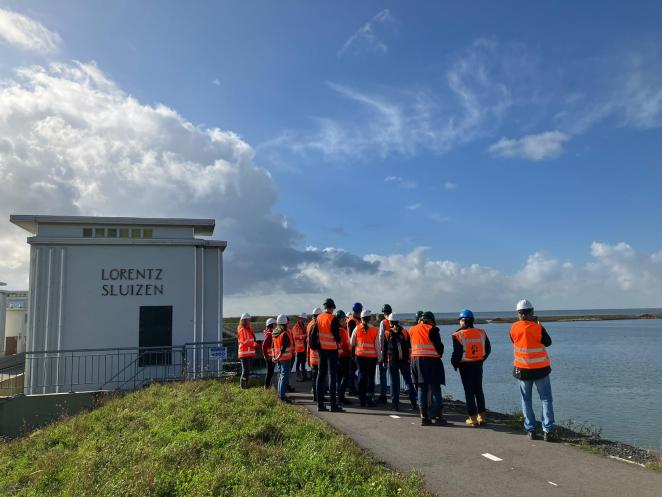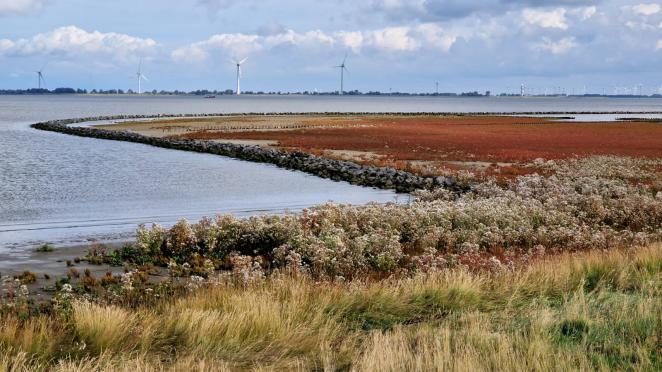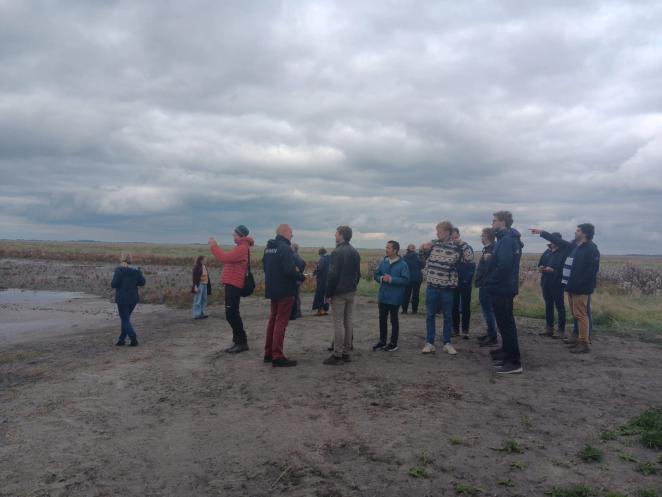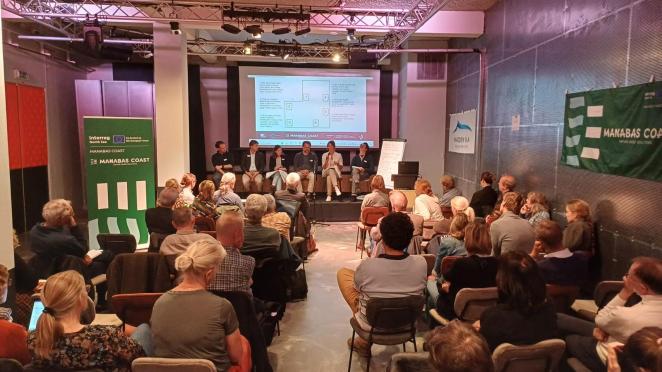From Monday, October 7, to Friday, October 11, the MANABAS COAST project group embarked on a series of inspiring field visit across the Dutch and German Wadden Sea coasts. This journey provided an in-depth exploration of cutting-edge coastal protection and nature-based solutions, and fostered valuable discussions among project partners on how to mainstream these solutions. Here’s a day-by-day account of the week’s activities.

Day 1 – The Afsluitdijk and fish migration river
On Monday, the MANABAS COAST group visited the iconic Afsluitdijk and the Fish Migration River. The day began with presentations by experts including Emiel Boerma from Rijkswaterstaat, Sophie Lauwaars from Rijkswaterstaat on the ecology of the Afsluitdijk, and Wouter van der Heij from the Wadden Association on the Fish Migration River.
The group explored the new storm surge barrier at Kornwerderzand and the opening in the Afsluitdijk that facilitates the Fish Migration River. Participants were also introduced to the innovative revetment along the Afsluitdijk, where rocky coastal vegetation thrives between Quattroblocks, and a herb-rich grassland, featuring 19 species, grows along the inner embankment.

Day 2 – Ems-Dollard coast: Marconi and the Brede Groene Dijk projects
On Tuesday afternoon, the focus shifted to the Ems-Dollard (ED) coast, where the group explored inspiring projects under the ED2050 programme. The first stop was the artificially created salt marsh near Delfzijl, part of the Marconi project. Participants learned about the purpose of this salt marsh and its role in coastal protection and ecology.
The visit continued with the "Brede Groene Dijk" (Wide Green Dike) project, an innovative approach by the Hunze and Aa’s Waterboard to strengthen sea dikes using locally produced clay. The group observed a completed 750-meter section of this dike, a pilot that demonstrates the feasibility of the concept. We learned that the feasibility was much influenced by current legislation, which defines quality characteristics for the clay being used. The waterboard now aims to extend this innovation to 17 kilometres of dike, presenting challenges and opportunities for future coastal protection.

Day 3 – How-to groups and nature-based solutions
Wednesday began with presentations from the how-to groups, which had been established at a previous project meeting in Bruges. These five groups have been working for six months on various "how-to" questions, such as how to implement nature-based solutions (NBS) in Natura 2000 areas. Each group shared their progress and the lessons they have learned so far, which will later be summarized in a two-page document aimed at sharing knowledge and strategies for future projects.
In the afternoon, the group visited a nature-based solution along the Lower Saxony coast. Implemented by the Lower Saxony Water Management, Coastal and Nature Protection Agency (NLWKN) and the National Park Authority, this solution involved lowering the ground in the dyke foreland to foster salt marsh development. The cooperative project not only improved the ecological condition of the salt marshes but also provided NLWKN with clay for flood protection. This win-win solution highlighted the value of interdisciplinary cooperation in coastal management.

Day 4 – Salt marsh management workshop
On Thursday, CWSS and the MANABAS COAST project organized a workshop to discuss the future of salt marsh management. The key question, "How much salt marsh management do we want and need?" sparked a lively debate among the 60 participants. The conversation centered on the challenge of balancing ecological, coastal protection, and sustainability goals in the face of rising sea levels. The group was split into six sub-groups to discuss the sub-challenges. For example, how to change salt marsh management under climate change. The workshop provided valuable insights into how these goals can be aligned to ensure long-term coastal resilience.

Day 5 – Groningen salt marshes
Friday’s excursion began early at the picturesque sluice of Noordpolderzijl, where the Noorderzijlvest Waterboard led the group along the dike, discussing the challenges of coastal protection in this unique area. The visit included the Klutenplas, a nature reserve created from a former clay mining site for dike reinforcement in the 1980s. This site demonstrated how coastal protection and inland nature development can be harmonized.
The group concluded their journey with a visit to the dike between Lauwersoog and Vierhuizen. Here, dike reinforcement efforts have been combined with measures to improve the natural environment. New salt marshes, artificial reefs, and tidal pools have been created, and a 70-hectare inland slack water nature area has been connected to the surrounding landscape. This project exemplified the integration of coastal protection with environmental enhancement, a key theme of the MANABAS COAST project.
For more information on these projects, visit:
- Eems-Dollard 2050
- Marconi Project
- Brede Groene Dijk Project
- Lauwersmeer Dike Nature Projects
- Klutenplas - Het Groninger Landschap
- Vismigratierivier
- De Afsluitdijk - Straks weer klaar voor de toekomst
As a red thread through the five days, the excursions were framed as a ‘mainstreaming road trip’ in which the Manabas group was nudged to reflect on the status, objective, and enabling and disabling conditions of mainstreaming nature-based solutions at the visited sites in comparison to the pilots and organisations which the participants represented. Because of the diversity of areas of expertise and contexts around the North Sea, these reflections provided for valuable discussions and offered informative insights for both the visited sites as well as for the pilots and organisations ‘at home’. As such, this week of coastal exploration and knowledge exchange reinforced the importance of transnational learning about coastal protection in the face of climate change and rising sea levels. The Manabas Coast project continues to pave the way for sustainable and resilient coastal management along the North Sea coastline.
